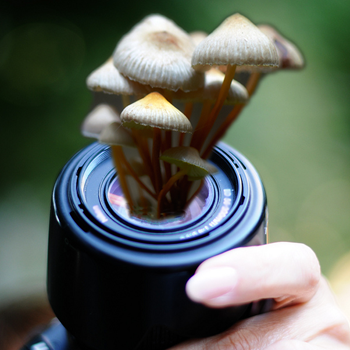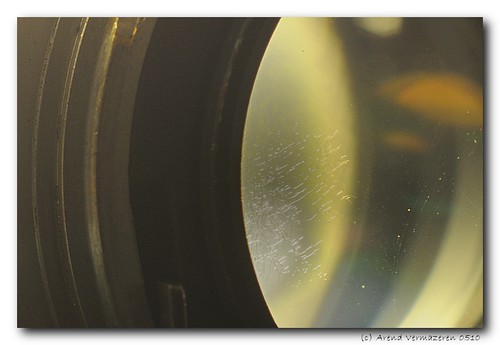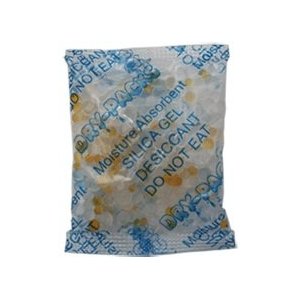
Fungus. Not exactly the first hazard that comes to mind for lenses, but it is very real and a lot more common than you would probably expect. Those of you who have lived in wet or humid areas probably have a good understanding of fungus and what a pain it can be. When moisture finds its way into the lens element groupings and is allowed to stay, it is a perfect habitat for fungus to start growing. Some lenses are more prone to developing fungus than others, but any lens is at risk. Often fungus in the lens renders the lens beyond repair. This can be upsetting because it looks as though the elements just need to be cleaned off. To find out why and how to help prevent this from happening to your lenses, continue reading.
 Identifying fungus inside a lens can be a little tricky sometimes. It can spread throughout the lens infecting all of the elements. You may think that your lens is immune because it has seals and weather proofing but “sealed elements†can grow fungus just as easily. Not all lenses are created equal, because of that some are easier to inspect than others. The only way to find fungus is to see it, which means that you must be able to look through the lens with the aperture wide open. Fungus can manifest itself in a few ways; most commonly it will look spotty, patchy, or have a web like pattern. It can be a haze that looks almost like fog or hard water spots, but it can also have an opaque gray or green coloration to it. When it gets bad enough, it will affect image quality. It will cause blurry and/or soft, low contrast images.
Identifying fungus inside a lens can be a little tricky sometimes. It can spread throughout the lens infecting all of the elements. You may think that your lens is immune because it has seals and weather proofing but “sealed elements†can grow fungus just as easily. Not all lenses are created equal, because of that some are easier to inspect than others. The only way to find fungus is to see it, which means that you must be able to look through the lens with the aperture wide open. Fungus can manifest itself in a few ways; most commonly it will look spotty, patchy, or have a web like pattern. It can be a haze that looks almost like fog or hard water spots, but it can also have an opaque gray or green coloration to it. When it gets bad enough, it will affect image quality. It will cause blurry and/or soft, low contrast images.
 Fungus “destroys†a lens by eating away the coatings on the elements. Apart from being very difficult to remove in the first place, when an element’s coatings are gone, it no longer functions as well as it is supposed to. The only option is to replace the element at that point; elements are the most expensive parts of a lens as you could probably already guess. Factor in the intense labor it takes to perform these repairs and it usually isn’t worth doing, thus rendering it “destroyed.†The other major problem with fungus is even if it hasn’t eaten the coatings and cleaning it off appears to work, fungus will almost always re-grow. This is another reason why it is best to replace the effected element.
Fungus “destroys†a lens by eating away the coatings on the elements. Apart from being very difficult to remove in the first place, when an element’s coatings are gone, it no longer functions as well as it is supposed to. The only option is to replace the element at that point; elements are the most expensive parts of a lens as you could probably already guess. Factor in the intense labor it takes to perform these repairs and it usually isn’t worth doing, thus rendering it “destroyed.†The other major problem with fungus is even if it hasn’t eaten the coatings and cleaning it off appears to work, fungus will almost always re-grow. This is another reason why it is best to replace the effected element.
 The best way to not feel the effects of fungus is to prevent it all together. Obviously you want to try and keep it dry. Ever see those little packets inside newly purchased bags or shoes called “silica packs?†Those are there to keep moisture out of those products and prevent fungus growth. If you are in a moist climate it would be a good idea to store your equipment with those. Even if you aren’t in wet or humid environment there are places that are worse than others for storage; those include outside (like a shed), basements, or a bathrooms. You can use rice but you have to be careful not to let the grains or rice dust get into the equipment. Should you discover it, the best thing to do is get it into a service center as soon as possible!
The best way to not feel the effects of fungus is to prevent it all together. Obviously you want to try and keep it dry. Ever see those little packets inside newly purchased bags or shoes called “silica packs?†Those are there to keep moisture out of those products and prevent fungus growth. If you are in a moist climate it would be a good idea to store your equipment with those. Even if you aren’t in wet or humid environment there are places that are worse than others for storage; those include outside (like a shed), basements, or a bathrooms. You can use rice but you have to be careful not to let the grains or rice dust get into the equipment. Should you discover it, the best thing to do is get it into a service center as soon as possible!

Image Credits (from top to bottom): “mushrooms” Gnilenkov Aleksey & “Lens” 14zawa (Composite image), “_IMG4552” OzAdr1an, “fungus” Arend Vermazeren, “Lens Fungus” JohnBanbury, and Dry-Packs Amazon Product Image of silica gel packet